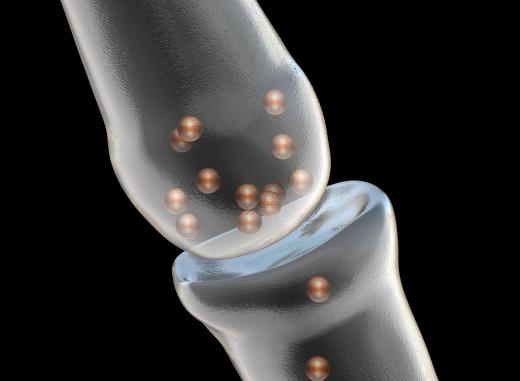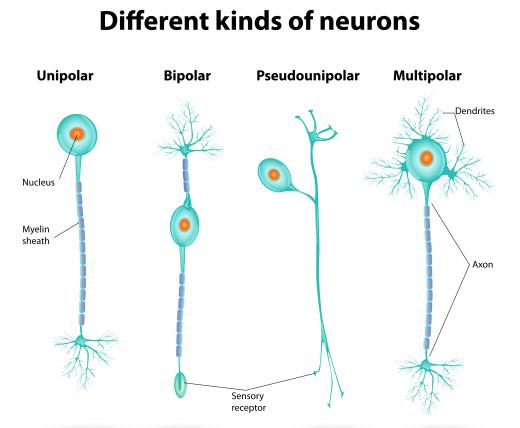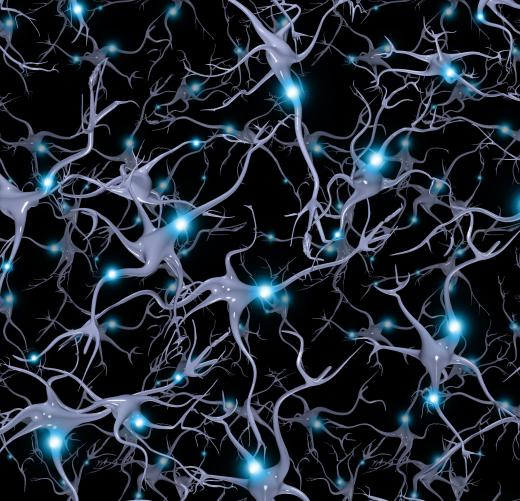What is an Electrochemical Process?
An electrochemical process is a chemical reaction that either causes or is caused by the movement of electrical current. These processes are a type of oxidation-reduction reaction in which one atom or molecule loses an electron to another atom or molecule. In electrochemical reactions, the atoms or molecules in the reaction are relatively far apart from each other compared to other reactions, forcing the electrons being transferred to travel a greater distance and thereby produce an electrical current. Many natural phenomena are based on electrochemical processes, such as the corrosion of metals, the ability of some sea creatures to generate electrical fields, and the workings of the nervous systems of humans and other animals. They also play an important role in modern technology, most prominently in the storage of electrical power in batteries, and the electrochemical process called electrolysis is important in modern industry.
The activities of nervous systems, from the simple reactions and instinctive behaviors found in even primitive animals to the complex learning and reasoning abilities of human beings, depend on electrochemical processes. Neurons use electrochemical processes to transmit information through the nervous system, allowing the nervous system to communicate with itself and with the rest of the body. To send a signal, chemical processes in the neuron generate an electrical impulse that is sent through an elongated structure called an axon until it reaches the synapse, the point of contact between the neuron and neighboring cells. At the synapse, the electricity causes the release of chemicals called neurotransmitters, which cross the synapse to the cell being signaled. The neurotransmitters then chemically bond with structures called receptors on the target cell, setting off further biochemical processes within it.

The ability of fish such as electric eels, stargazers, and torpedo rays to produce electric fields is the result of an electrochemical process. Electric fish possess specialized cells called electrocytes. Transport proteins bind with positive potassium and sodium ions in the cell and carry them away, building up an electric charge in the cell. When this electricity is needed, a part of the nervous system called the medullary command nucleus sends an electric impulse to other nerve cells, which triggers the release of the neurotransmitter acetylcholine. The neurotransmitter bonds with the acetylcholine receptors of the electrocytes, which triggers the release of the electrocytes' charge.

Electric batteries use electrochemical processes to store and release electricity. Chemical reactions within the electric cells making up the battery create a difference in charge between the two halves of each cell, producing electrical current. Rechargeable batteries produce electricity with chemical reactions that are reversible, and so can be returned to their original chemical configuration if electricity is applied from an outside source. The reactions in nonrechargable batteries do not have this quality, though they usually produce more electric power than a rechargeable battery can provide in a single charge.

A variety of different chemical reactions are used in batteries. Nickel-cadmium batteries, which are commonly used in lights and household appliances, are based on separate reactions of cadmium and nickel with an alkaline, usually a solution of potassium hydroxide (KOH), and water. Nickel-metal hydride batteries are similar, but replace the cadmium with an intermetallic compound made from manganese, aluminum, or cobalt mixed with rare earth metals such as praseodymium, lanthanum, and cerium. Lithium batteries can use a variety of reactions involving lithium compounds, with the most common type using manganese dioxide (MnO2) and a solution of lithium perchlorate (LiClO4), dimethoxyethane (C4H10O2), and propylene carbonate (C4H6O3).

Electrolysis is an electrochemical process in which electrical current is used to trigger chemical reactions in a substance containing free ions, called an electrolyte. The electrolyte is either melted or dissolved in a solvent, and two electrodes, called the anode and cathode, are immersed in it. When an electrical potential is applied between the electrodes, electricity begins to flow between them, and each electrode begins attracting ions with the opposite of its own charge. The ions gain or lose electrons to the electrodes, causing oxidation of molecules near the anode and reduction of those near the cathode. Electrolysis is used in many areas of industrial processes, including metallurgy, the production of chemicals such as potassium chlorate and (KClO3) trifluoroacetic acid (C2HF3O2), and the extraction of highly reactive elements that are not found in their elemental form in nature, such as sodium and magnesium.
AS FEATURED ON:
AS FEATURED ON:














Discussion Comments
I have a feeling that scientists will eventually find the right materials to construct batteries capable of running cars for days at a time or keeping electronic devices working for more than a few hours. I think the right combination of elements will create an electrochemical process ten times more efficient than the ones we rely on today.
Post your comments